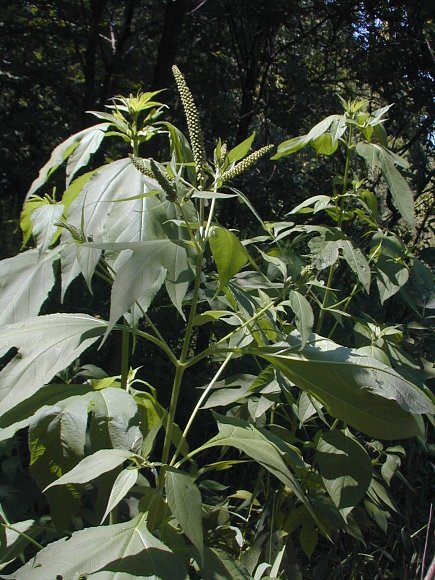
Some 18 generations ago — 600 years ago give or take a century or two — some Natives Americans stopped cultivating a particular crop and may have moved on to maize. About 150 years ago — five generations — American farmers were raising crabgrass for grain when they, too, moved on to corn, the descendant of maize. So what crop did the Indians stop growing? Ragweed, the most hay-fever causing plant in the world. No one alive knows why Ragweed fell out of cultivation though the development of maize is a prime guess. And Ragweed certainly is not favored by farmers now who view it as a vile invader that chokes domestic crops. Perhaps it’s time to reconsider Ragweed.
The grain is some 47% crude protein and 38% crude fat. That’s an energy powerhouse despite the size. The seed oil is edible and at least one person alive today has eaten a small hand full of seeds. They taste like wheat bran. In excess of 5,000 seeds can be produce per plant. Generally said Ragweed is not an “antique vegetable” as such things are sometime called. But, it might be a lost grain. Ragweed oil is on par with soybean oil and the plant produces about the same amount as soybean, one fifth the seed weight. Some reports say natives would grind the seeds, bring them to boil in water, the oil would float to the top, then was ladled off.
While one could argue this is much to do over some oil but fat is essential to survival. You absolutely cannot live without some source of fat. Oil would have been extremely important to native populations and could be again if we were ever forced to provide our own food. And unlike soybean which has to be cultivated, Ragweed is a weed that can do all right on its own. One debate in the ethnobotanical community is whether the natives cultivated a huge version of Giant Ragweed or not. One study says yes because the seeds that were found were larger than found in nature. Another study says no reporting that there are large seeds in nature as well. Bit of a toss up there. But we know animals certainly ate them and still do. In fact Ragweed is one of the few seed-bearing plants that stands above deep snow providing valuable creature food during the winter. It’s on the menu for the Eastern Cottontail, Meadow Vole, grasshoppers which eat the leaves, Dark-eyed Junco, Brown-headed Cowbird, Northern Bobwhite, Purple Finch, Mourning Dove, American Goldfinch, and the Red-bellied Woodpecker. Sheep and horses also like to eat the plant. What about humans eating the hard seeds or foliage? There’s a lot of speculation but few hard facts.
An article on the plant at Michigan State University for the W.J.Beal Botanical Garden says: “…some archaeologists have suggested that … the seeds were impractical as a food source. However, the fact that Indigenous Americans were specialists at navigating starvation episodes, combined with the observation that giant ragweed seeds are comprised of about 19 percent edible oil, make it fairly certain that these seeds would not be overlooked as a food resource.” No details given. A weed ecology fact sheet for Ohio State University says: “One of our few native weeds. Seeds eaten by pre-Columbian Indians.” Again, no details. In the book Archaic Societies: Diversity and Complexity Across the Midcontinent by Thomas E. Edison (2009) it mentions a 1997 it report (Gremillion) that Ragweed seeds were found in paleofecal material from 950 to 1400 years ago along with sunflower seeds and sumpweed seeds. It’s difficult for a seed to end up in an ancient bathroom unless it was eaten. In 1984 Peter Goodchild published Survival Skills of the North American Indians. On page 209 in a list of “food plants” he writes for the Giant Ragweed “cultivated for its seed in several areas.“
Was Giant Ragweed cultivated? It would seem so, and for its grain. It’s definitely in the ancient farmers crop line up but then falls away. The next question is was it raised to eat the grain or for the oil, or both? It’s not easy in modern times to be aware of past practices. For example, some suggest the natives crush the seeds and boiled them for oil (not unlike acorns.) Possible yes, but is it probable this was done for food? In communication with Goodchild he writes:
“Judging from other uses of oily seeds, the natives are unlikely to have done any processing of the seeds. Generally that’s not practical without modern machinery. I’ve even experimented myself with sunflower seeds, and found no practical (primitive) method of getting the oil out — it’s far easier just to eat the seeds”

Thus while the seeds have oil its extraction might not have been the prime use whereas eating the grain could have been. But might I offer a variant of that? From a calories-in calories-out point of view — or level of difficulty — many ancient foods would not be consumed. They just were not worth the effort as food. Among them could be smilax root starch and pokeweed greens. Getting the starch out of a smilax root is a Herculean task that burns far more calories than is produced on consumption. And boiling pokeweed twice does not make caloric sense when boiling was difficult and other nutritious leaves could be eaten raw. What I suspect was whilst in the pursuit of medicine — which is not a calories-in calories-out dependent task — it was discovered various plants had other edible parts. Medicinal needs could justify calorie-deficit tasks. And while fat was obtainable from animals a plant oil might have its medicinal applications. So perhaps the Giant Ragweed could have been used for food and for oil but the latter in a medicinal sense. Ragweed oil might have been too valuable to eat but worth the effort to obtain medicinally. Another possible aspect professional archaeologists never seem to consider is that long ago the menu changed only with the seasons. They would dismiss Giant Ragweed grains as too small or not worth the effort to make a stable crop, and that may be true. But, such grains were another flavor and texture to add to the limited, slow-to-change diet. We sprinkle pine nuts on pesto. Might they have done something similar?
As for allergens, Ragweed is second only to mold in causing allergic symptoms. There are 17 species of Ragweed in North America. The common ragweed (Ambrosia artemisiifolia) can produce a million grains of pollen per plant daily, the Giant Ragweed (Ambrosia trifida) can create in excess of 1.25 million grains daily and over a billion during its life cycle. This leads to a lot of cross pollination and plant variation. Left on its own Ragweed is a riparian plant living along rivers and local flood plains. Isolated patches depend upon the wind to carry the pollen. With the migration of man so went the Ragweed and the number of plants and the amount of pollen carried by the wind. Ragweed has multiple antigens but the strongest is Antigen E. There are also several plants that in the greater Ragweed family that can cause allergic reactions including sage brush, marsh elders, poverty weed, cocklebur, desert broom, groundsel bush, feverfew and dog fennel. Goldenrod is unfairly blamed for causing allergies because it blooms at the same time as Ragweed. But, its pollen is too heavy to be windblown. (Here’s a botanical hint: Green flowers, in particular small green flowers, are usually wind-pollinated. They aren’t colorful enugh to attract insects for pollination.)
There is also at least one Ragweed with a root the natives ate, Ambrosia tenuifolia, Slimleaf Burr Ragweed. Professor Daniel Moerman reports the Papago Indians dried the roots in the sun and used them as a staple crop (that would be in Arizona.) They also ate the stalks as greens. However the USDA lists Ambrosia tenuifolia as only growing in Louisiana and Puerto Rico. That particular Ragweed it is native to South America and has been naturalized in Spain, France and Italy. Why it is missing from Arizona now is anyone’s guess. Elsewhere natives used Ragweed stalks for rope. The stems and leaves of Ambrosia peruviana were and are used as a green dye. Various species were also used medicinally, see Herb Blurb below.
As for the binomial name, Ambrosia is usually translated into English as meaning “food of the gods.” A direct translation from the Greek means “unmortal” or “not mortal.” In Greek mythology “ambrosia” was sometimes the food the gods ate and or wine they drank which gave the gods (and demigods) immortality thus called “ambrosia.” But, food and drink were used interchangeably thus for some ancient writers “ambrosia” was food and for others it was drink which was also called nectar, Greek NEKtar which means “death overcoming.” Ambrosia is close to the older Sanskrit word Amrita which means “without death.” Clearly there was a long-running theme here. Greek gods, who always had human failings and consequently were far from perfect, were what they ate and drank, not unlike people today. Why a rather nondescript plant that is a prime allergen would be called Ambrosia is anyone’s guess. No hints were left.
A couple of more things: The common ragweed, Ambrosia artemisiifolia, is the most efficient plant to remove lead from the ground. And I know a retired doctor in south Florida who tells me he’s eating Ragweed, Ambrosia artemisiifolia. Like Pokeweed he is boiling it twice in this case to moderate the flavor. We know from his experiment this apparently does not cause any acute toxicity or quick reactions. However, a steady diet of Ragweed might cause issues over the long term, or might not. We just don’t know.
Green Deane’s Itemized Plant Profile: Giant Ragweed
IDENTIFICATION: Annual 3 to 12 feet tall, branching occasionally. Green stems covered with white hairs, leaves opposite to a foot long and eight inches wide, larger leaves divided into 3 or 5 lobes, usually serrated along the edge, long petioles sometimes winged. Smaller leaves near the base of flower lance-shaped, often hairy underneath. Upper stems terminate in a cylindrical flower spike to six inches long. Small flowers yellowish green, no petals or sepals, drooping clusters.
TIME OF YEAR: Flowers late summer or early fall, seeds follow, large, tough-coated, viable for many years.
ENVIRONEMENT: Full sun to light shade, moist, fertile soil. It is native to 47 of the 50 states missing Nevada, Hawaii, and Alaska.
METHOD OF PREPARATION: We have no idea. Perhaps ground seeds boiled in water, oil skimmed off the top. Perhaps the seeds were parched then eaten. A few can be eaten raw. Beyond that there is no modern report of consumption other than the doctor I mentioned above.
Herb Blurb
Te genus yields volatile oils. quercetin, and bitter alkaloids. Plant extracts are anti-bacterial and anti-viral. Ambrosia ambrosioides; a tea was made from the roots and given to women after birth. Ambrosia confertiflora; used to cure diarrhea, flowerettes chewed and followed by a drink of water. Ambrosia cumanensis; herb teas for yellow fever, constipation, menorrhagia. Herb juice for pleurisy. Root or herb infusions for colds, flu, fever, in postpartum depurants. Herb of second growth crushed leaves mixed with chicken fat and/or hot water, cool mixture rubbed on the body to reduce fever. Ambrosia elatior as a poultice. Ambrosia hispida was used to relieve fever, stomach ache, pain, loss of appetite, and flu. To boiled leaf tea they added salt to to increase the appetite then drank the tea for nine mornings. Lemon juice and salt was added when it was used for gas and colds. A weak leaf tea with salt was used to relieve menstrual pain (again taken for nine mornings.) It was also a “granny” medicine to “clean everything out” after childbirth. Tea from fresh plant less better than tea from dried plant. Ambrosia psilostachya, a bitter decoction taken to relieve fever.
Journal of Northeast Forestry University 2008-01
GC-MS Analysis of Fatty Acid Constituents in Ambrosia trifida Seed Oil
Zhang Lin,Yang Lei,Niu Huiying,Li Xiaowei,Zu Yuangang(Key Laboratory of Forest Plant Ecology of Ministry of Education,Northeast Forestry University,Harbin 150040,P.R China)
Seed oil extracted from the seeds of Ambrosia trifida through solvent extraction was analysed by GC-MS after esterification. Four components from six peaks of the fatty acid constituents were identified.The main constituents are linoleic acid and oleic acid,and the relative contents are 81.60% and 14.73%,respectively.

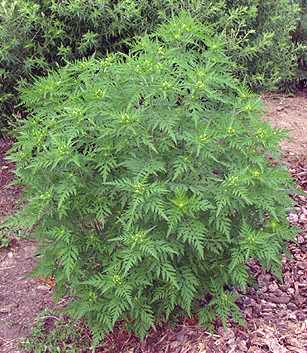
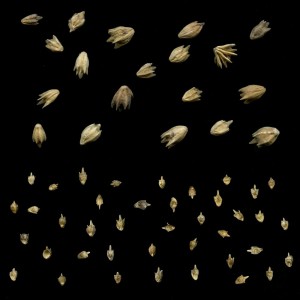

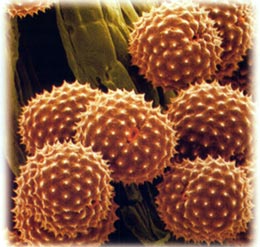
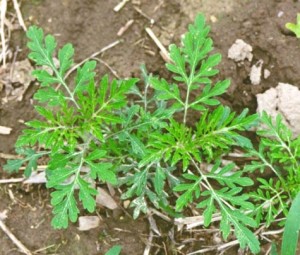


I’m pretty sure we have Ambrosia tenuifolia in our yard here in Tennessee. It grows all through our garden and is easily mistaken for the marigolds I plant to inhibit root nematodes. The other day my husband and I were discussing what uses ragweed must surely have so this article is very timely for us. Has it ever been used as a fiber plant?
the article mentions its use as a fiber source
Ambrosia trifida grows all over the place around here: Dallas, Texas. It makes for a fair hand drill spindle. I have also used it for bow drill, the spindle & hearth, with success.
Amazing article. I work on a split-operation half-organic farm in Manatee County Florida. Common Ragweed is the most prolific “weed” growing between our crop rows. We try to look at weeds as a response mechanism to improve the soil and the fact that it removes lead makes me wonder if that’s part of why we have so much of it.
Interesting thought. If you can afford to have the ragweed from your soil tested, we would greatly appreciate your sharing the results. Maybe a bright young student would be interested in including your ragweed in their studies, as bio-remediation of toxins in soils and water is very much in vogue in the academic world.
I have seen ragweeds thrive on rich soils that were unlikely to have had high levels of lead, but I do not have anyalysis on those soils proving this.
Another interesting question is: how available is the lead accumulated in the ragweed to humans or animals consuming various portions of the plant?
Hi Thomas
I’m in Collier county and want to get some live ragweed to make a tincture for mercury positioning, as recommended by Edgar Cayce in reading 1880-1 (along with using castor oil packs). Do you have enough to share? Thanks! Donna
Hi Donna, did you ever get to make your tincture? Please email me tanyahylton@yahoo.com
Does any one know if Ragweed seeds have gluten in it?
Those sensitive to gluten would be well advised to learn the natural sources of gluten and also possible gluten contamination of other foodstuffs and/or processed foods to which gluten has been added. Apparently gluten can be used as an additive to stabilize food products without appearing on the label under current labeling requirements.
Naturally, gluten occurs only in cereal grains of the grass family including wheat and closely related species: barley, rye, and triticale (a hybrid cross of wheat and rye). Some variaties of oats may contain gluten, but storage and handling of grains and grain products can lead to glutens from other grains appearing in the oats.
Maize (corn) and rice do not contain true gluten (unless contaminated in handling/processing or if gluten is used as an additive to foods containing corn or rice).
Anyone might have or develop a sensitivity to essentially any food. BUT, ragweed is not a plant in the grass family; ragweed seeds are not cereal grains; and ragweed seeds do not contain gluten.
Finding reliable information on topics that affect our lives is an important life skill for those of us living in the ‘misInformation Age’. But it is something that we should all learn to do for ourselves, particularly where our health is concerned. Please do not take my word for anything, but check all information for yourself. Best wishes.
Interestingly, my dogs love giant ragweed. There is a large patch of it growing on an empty lot on our street and whenever we walk past it the dogs yank us over to it so they can graze on it. We didn’t teach them this behavior at all, but our dog that might be part wolf honed in on it the first time he saw it. They tear the leaves off the plant and munch on them. And it’s not like when dogs eat grass- they don’t get sick and vomit it out. They eat it and seem to digest it very well. They’d sit there eating it all day if we let them. They also seem to enjoy foraging for spiderwort, loquats, clover, chickweed, and goose grass! Who needs dog food?
My dogs love it too! I’ve seen some articles that suggest it’s bad for them, but I haven’t seen any ill effects.
Just speculation, but I wonder if the “ambrosia” taxonomy speaks to ragweed as a nectar plant for bees. A late summer bloom of cascades of yellow flowers might be (or look like, to a beekeeper) a big draw as the hot summer dearth ended and some of the early fall flowers (goldenrod is a big one here in Atlanta) started to come online. Europeans brought Apis with them when they came here, and the bee’s path mirrored theirs, so early settlements of Europeans might have marveled at the flowers apparently contributing “ambrosia” to the bees who were making their sweeteners.
Ahhh Giant ragweed, mis-guided teenagers always think this yummy guy is either hemp or a cannabis specimen.
I was worried when my goats mowed it down with their jaws. I had heard it would cause fever and boil your brain. The goats are fine I cant say the same for the ragweed crop in the yard. or shall I say that was in the yard. LOL
Regarding Kara (post #8) and her dogs:
My basset hound loved chewing on the roots of ragweed and burdock. I never knew why, but if I got one for him he couldn’t leave it alone until it was all gone. He’d chew and eat as many as I gave him. The roots are carrot-like in appearance, and I ate small ones from our backyard raw when I was a kid.
Glad to know other dogs enjoy these things. You’re right….who needs “dog food” anyway?
i noticed that deer really like giant ragweed, but won’t touch common(minus a small nibble, maybe some medicinal benefits) they they literally took every leaf off of the big healthy plants.(as found in my garden, oh they liked the smartweed to) 😉
Thank you for this post. I suffer from ragweed allergies, so I’m glad there’s some goodness in the plants. I heard that the leaves and blossoms of the plant can be made into a tea and lessen allergies. After several hours of research, I gathered some common ragweed near my place in WI, and put them in a dehydrator. Since the ragweed I found was very young, I got a bit of a scare when I found out that Conium maculatum (poison hemlock) grows in my area and has similar leaves, though the stem and flowers are quite different. Since the ragweed was too young to see the lack of purple conium blotches on the stem, I didn’t want to take any chances and tossed all the ragweed leaves. I just used one sprig of blossoms in a test-tea (since even a novice like me can tell ragweed blossoms from conium blossoms) I had a few test-sips, and then went back to work. However, I began to not feel well, even dizzy, so I wonder if I had an allergic reaction to even the dried ragweed tea? Has anyone heard of this happening?
Could you have been dizzy from your allergies in general? I work with ladders painting in the summer, and when my allergies get bad, sometimes it affects my ears and my balance, and I get extremely dizzy / woozy here and there when the inner ear canals get blocked from regular ragweed pollen allergies.
You should make the tea from the leaves…not the blossoms. You are allergic to the pollen, but the leaves, before the plants blossom have an antihistamine in them. I study herbalism here in Austin, TX and we make local allergy tinctures with a large percentage of the formula being tinctured Giant Ragweed leaves harvested BEFORE it flowers. Hope this helps.
The leaves—picked BEFORE any blooms appear can be chewed and the juice swallowed, relieving sinus and nasal congestion almost instantaneously, IF there is no tincture on hand, for instance when you’re out hiking, etc. Otherwise, it’s a good idea to make enough tincture to last til next season’s harvesting time.
allergies to members of the Aster/Composite family are not uncommon.
Wonderful knowledge. Thank you. Have so much ragweed on our pasture, and was wondering if we can harvest it before it blooms and goes to seed, and eat the leaves or roots, boiled, stir-fried, raw? Or just wait and eat the seeds? Raw, cooked? Thank you oh wise people of the Earth for reviving this lost knowledge. 😉
I eat rag weed in place of cultivated greens because it is so plentiful and I don’t have to plant it (no planting or care required). I pick the plants when they are young till they are medium sized, before they grow seeds. Eat them the same as you would spinach. Friends from the Congo like them best in stuffed fish or just steamed. I like them fried in my eggs or raw in my salads.
I has some ragweeds in my yard and it tasted kind a good so I try to find out if it is edible. Apparently it is. If you ate it before, please let me know. I am eager to give it a try as I love vegies.
Thanks all
I know if you boil it twice you can eat it without any acute effects because I know someone who’s done that. But I have no idea about consumption long term.
I was also wondering if ragweed leaves could be eaten in salad, raw. Or cooked like kale?
No, not that I know of. If that were part of the ethnobotanical and reported use I would have mentioned it.
I followed directions I found on making a ragweed tincture that called for boiling the leaves. I used Giant Ragweed and was rather surprised by the super buttery smell and tried a bite. Other that having a rough texture, the boiled leaves taste amazing. I had three bites, no ill effects. Do you know of any toxicity, or is there just not much that we do know about it…other than the grain aspect?
keith posted he eats them raw routinely in this thread
I frequently eat the leaves of giant ragweed, raw right off the plant. It seems to be a general anti-inflammatory in my case. I’ve also make a decoction from the leaves and drank that every day for several weeks in a row with no ill effects.
I’ve fed it to my rabbits every day for weeks on end with no ill effects. My rabbits seem to prefer it over all the other weeds I feed. My horses also love it and will eat a patch down to the roots if they get to one.
I am going to try some ragweed here in South Florida as soon as I can get back to the patch I found.
Really interesting article! I was looking for information on how to harvest the seeds. I am wondering if they could be added to baked goods like chia is. Thank you for sharing all your information!
can you reduce allergies by making a tea out of the leaves?
With apologies, I have no idea. I am not an herbalist and most certainly have no medical credentials at all.
ahh ragweed, %$&^&*%^ and $%^&^ lol , I used to always love walking in the way back woods as a kid, this plant always amazed me because it is one of the few plants with flowers on them in sept + and they are bright yellow. when I got to my teens I learned to hate it very quickly and the months that brought its bloom, lol.
I really think its a cool plant heh, and I love learning about what things can be used for survival, just never know and hard to miss this plant for sure,,, could easily gather a bucket full of the seeds quickly.
my question is, if you are allergic, will the oil from seeds still give reactions?
how many seeds would yield enough oil for say a cup to pint ect?
cool articly ,ty
Two plants that are dangerous to consume, if you are allergic to Ragweed, I have found from personal experience, are Stevia, and Milk Thistle. I almost died from an asthma attack from eating Stevia on a regular basis for several weeks, and had a severe upper respiratory reaction in the middle of winter from drinking tea with milk thistle in it. Stevia seems to be the most potent allergen for me, of all time.
were you eating stevia plants? Or the syrup that comes from it as a sugar replacement in many coffee shops these days?
My dogs love giant ragweed leaves. They never get sick after eating them or the wild hops and hackberry leaves they are so fond of. When I take them for walks they’re constantly sniffing for these three things, and pass up everything else. I’ve often wondered if the three different plants contain similar chemicals.
Our mostly Akita has GI issues. He seeks out giant ragweed at the park. Anita’s are an ancient breed, so maybe there is some medicinal properties he’s after.
I suffer from sever ragweed allergies which have worsened over the years. Also I am running out of medications that are working for me. My health insurance doesn’t cover allergy shots so running on the principle of desensitizing my immune system to the pollen I think I may try consuming it as an alternative therapy. Has anyone else ever tried this or thought about this?
Have you tried taking daily doses of local, raw honey? I have heard that helps to relieve allergy symptoms. Best of luck.
I am a hay fever sufferer myself and inherited that from my father. I am now 65 and have tried many things over the years to find relief, even Homeopathy which worked best of any without the bad side affects that come with many drugs which was marginally helpful, BUT, in 2003 while working in Louisiana on a track salvage job in October that year we were working a section of old rail that had Massive amounts of Giant Ragweed (10 feet or More) Biggest I had EVER seen growing all around us ! I got sick, Really Sick !! Tried a then newer over the counter allergy medicine that seemed to work until the 8th day of the 10 tablets that were in the box and then it quit working and I was right back to where I started….Sicker than an old dog ! Went back home for the winter season and after the first hard frost and a season of relief until September of 2004 and back to Louisiana and again Rag Weed Everywhere ! and as the month wore on so my hay fever. I decided to try something that is a principal of Homeopathy (Likes cure Likes) and not real sure what I might be getting myself into Ate the ragweed flowers ……and waited…. ! ! Is it working !?? SUCCESS ! My symptoms all but cleared up within about 20 minutes ! Fast forward to September 2016 North West Arkansas and could tell I might be in for a rough season so I decided to go all out and give it a Real roll and went to the country and gathered a quart size zip bag (I keep in the freezer) full of flower tassel’s and have been eating 3 to 4 full tassel’s a day for over a week now. It seems to be working fine though I have had a rough moment or two the ragweed season still has at least another month or so to go and I seem to be getting better not worse !
Do you just hang it and let it dry like tobacco?And,at what stage of growth do you harvest it.
I would say that it couldn’t hurt to try. It’s not poison so won’t kill you. You know that poison ivy is used that way. If you are allergic to it you take the tiny new red leaves in early spring, pinch them off with gloves and chew throughly for 14days once a day and it keeps you good for the season…. I’d say give it a try. If the tea doesn’t work, try the roots, if the roots don’t work try cooking as greens, if that doesn’t work try the new young leaves even if bitter, which may be the first you should do…. good luck. Let us know. peace
I have been eating ragweed leaves as a digestive and it works better than the Swedish bitters I bought to get my digestion going. I usually have horrible allergies to the ragweed so I got desperate and tried the “hair of the dog that bit me” idea and started eating the leaves. They are way more bitter than the Swedish bitters but they stopped the allergy attack. I noticed the pollen still made the allergies worse so I stuck to the leaves. The leaves are frilly not straight. The straight leaves might be goldenrod which is not effective. Ragweed has green inflorescences.
I have eaten the flower spikes off and on for over 30 years. I enjoy them. One time I picked a lot of them, put them in pint jars and poured a hot pickling solution on them. Brought them to a pot luck dinner and called it pickled scrog weed. Lots of people liked it. They will keep for years this way. Add some sliced onion in the mix. It turns a reddish purple color, I suspect it may contain anthocyanins. Good stuff.
Re: Ambrosia. I just came across this from a comment on another site: “Apparently, the answer to the mystery is simple: Linneaus, knowing that ragweed was so bitter it could render the milk of cows who grazed it unpotable, decided to make a joke. Swedish humor, you know. (That’s on the authority of Edwin Rollin Sencer, author of the Dover reprint All About Weeds.)”
All of the ragweed species in N America are very effective treatment/preventive for hay fever symptoms, IF harvested and chewed or tinctured BEFORE the plants bloom. Two or three dropperfuls of the tincture will clear the sinuses within a couple of minutes for most people.
I claim no expertise regarding edible plants other than things taught to me a lifetime ago by Mom and Dad, smart folks with mixed country and NA roots, as taught to them by their parents, and so on. I don’t recall specifically learning about many of these things, so it must have been largely by osmosis, but about 90% of the time it turns out to be at least partially correct. So, for what it is worth, the seed pods can be eaten and are not only tasty, but nutritious. I also believe that these pods are related to and have much the same appearance of what was purportedly the primary food-source of the Incas, and is still an important quasi-grain eaten in that area. The same as is now gaining wide acceptance the world over. Quinoa. I eat the latter regularly. I have eaten the former experimentally a number of times. They are quite similar in taste and preparation. A quick search confirms the two to be close botanical relatives.
I don’t know if we are communicating about the same species. I don’t think of Ragweed as having seed pods. But I do know the seed oil is edible if one is not allergic to the plant.
We live in Fort Lauderdale. We have been eating the Ambrosia Artemisiifolia, boiling it twice to take the bitter. I feel it s impossible to eat it raw in salads. We are surprised about people don t trying to eat it more often. We wanted to share our experience.
Wow! I just moved from Fort Lauderdale to Palatka, Fl. I have been following Dean Greens site for a few years now. I never bothered looking up ragweed because i thought no way is it edible. Do you mean the common ragweed that grows tall but has frilly like leaves? I keep seeing info about the giant ragweed, does that grow in Florida? If you ever head to Central Fl. Palatka you can come to our little farm.
Ambrosia tenuifolia is not missing from Arizona.
It is also a favorite food (seeds) of many birds including quail.
i accidentally found out that the leaves of the giant ragweed are delicious when cooked as a green. My dogs love to eat the leaves off the stems. i enjoy them raw as well, but they are very strongly flavored. strong sunflower plant taste. the roots of the small ragweed are quite delicious raw. i found that out accidentally as well when trying to weed a garden bed. They send out runner shoots in early spring. i have tried popping the seeds of the giant ragweed unsuccessfully. the seeds taste okay straight up, but the texture takes a little getting used to. I look forward to this plant here in north central texas, because in July and August it is hard to find happy plants growing with abandon if the heat has set in properly. The leaves are large enough to use like grape leaves as wraps for steamed rice and vegetables. They also make a nice tea, which is how i found out that the leaves were delicious boiled.
Lucy, Thanks so much for your accidental story of leaves and roots of ragweed. I have many of them and have always thought they had to have some use other than to have to pull up or curse at… I’ve been learning to eat the weeds more and more and am pleasantly surprised how much we have before our very eyes if only we knew how easy some foods are and grow on their own. We’ve been taught to cut & destroy rather than use and enjoy. Thanks again. Will be making tea and steaming rice with the leaves. peace & blessing
Looking for Giant Ragweed Seed aka Ambrosia trifida, for experimental purposes within a greenhouse environment. Would appreciate any leads.
I found this in our yard (giant ragweed), it’s flowering right now but if you are interested still I can save some seeds for you!
Our rabbits and dairy goats love the giant ragweed stems and leaves. I think I do too! I realized that in late spring/early summer, the tougher outer layer of the stem can be peeled back to reveal a tender, juicy, and palatable vegetable with an interesting flavor. I wonder how safe it is to consume it in moderate amounts (like as a side of fried stems with a meal). I suppose I’ve already been eating this plant processed via the goat milk!
We have a type if ragweed that only grows a couple of feet tall…i’ve tasted the leaves and they are not bad..I would like to know if kind is as good for you as the as the giant..??
This past summer we tried to grow wild flowers, only have this tall ragweed. Same thing happened to gardener at local nursery. So far plant hasn’t flowered, but maybe I’ll wait to pull it out, to see the yellow flowers? Liked the article, but found typos: wheat “brand” sh/b bran. “Ladle” sh/b ladled. 3rd one is toward end of article. Article could summarize how to use ragweed – in this era of Montanto messing with our corn, we may need it in future?
Any idea how closely related ragweed is to quinoa? Actual genetics and structure, not just the scientific classification.
Thanks
Thanks for writing. They are not related at al, not even distantly. The only group they share is that they both sprout with two leaves. After that they are totally separate.
Hello, does anyone know where I could actually purchase ragweed in Florida?
Purchase? I doubt it but it is nearly everywhere.
I am so glad I found this before I got rid of my bumper crop of ragweed. I have left it to shade the ground while my plants get going. Now I think I will leave some to harvest for medicine and other uses as I find them. Now I know what to search for. Through the spring I didn’t even know what the plant was. I took half a day last week searching weed guides and catalogs, it was not easy to find.
This is so interesting, I am really happy I found this article –can you tell Lol 😀
Evelyn
Thank you for mentioning bur ragweed…here in NV, it’s everywhere… And the burs are really nasty…
However, I will now endeavor to collect seeds, will see if they can be processed in any way to remove the outer bur husk… Definitely going to eat the leaves and roots…
The lead remediation sounds wonderful as well. Alot of mines here, alot of lead and mercury here as well. Thanks for giving the info on the poverty sump weed as well. Read some Where that it fixes selenium in it’s leaves… And that the pima Indians used it for flavoring…
Has anyone tried sprouting ragweed seed for edible sprouts?
Thanks for the great article and the comments!
2nd question: If ragweed is growing near an old house or barn, and you avoid eating the roots in case of lead uptake, are the leaves/blossoms/seeds still safe to eat?
Good point, I would avoid such locations.
Never knew it was edible. Just saw how our pastured pigs LOVE it! Thanks for the great ideas about eating this weed we have lots of!
We harvest giant rag weed to eat ourselves and to feed our rabbits and chickens. We love it steamed with nettles and lambsquarters.
I’ve started cultivating giant and common in my back yard (and have a pretty good forest of it!) as I found it’s way better at choking out the invasive motherwort better than I am by just pulling it up.
Started using it, sparingly so as not to take it all from the animals that depend on it way more than I do, in cooking as well.
Blanched, seasoned, and fried it tastes a lot like a combination of spinach and collard greens.
It’s also great in curries in place of or with spinach.
Personally, I find it a little bitter raw but the bitterness is lessened if it’s blanched and all but gone if it’s boiled until tender or fried until tender.
I use the flowers and leaves and probably get a few seeds mixed in with the flowers but don’t specifically check for them.